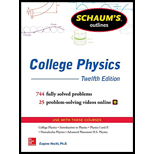
A series circuit consisting of an uncharged 2.0-µF capacitor and a 10-MΩ resistor is connected across a 100-V power source. What are the current in the circuit and the charge on the capacitor (a) after one time constant, and (b) when the capacitor has acquired 90 percent of its final charge?
(a)
The current in the circuit and charge across the capacitor in the RC circuit after one time constant when a series circuit consisting of uncharged
Answer to Problem 30SP
Solution:
Explanation of Solution
Given data:
Capacitance of the capacitor is
Resistance of the resistor is
The emf of the voltage source is
Formula used:
When a capacitor is connected to a battery, in the beginning the capacitor carries the current that keeps on decreasing till it is fully charged. Once the capacitor is fully charged the current through it is zero. This happens because a capacitor acts as a short circuit when it is uncharged and as an open circuit when it is fully charged.
The expression of current flowing through an RC circuit is
Here,
The expression of the time constant in term of resistance and capacitance is
The maximum current in the circuit at starting is
Here,
The expression for instantaneous charge stored in the capacitor is
Here,
The maximum charge stored in the capacitor.
Explanation:
Recall the expression of current flowing through an RC circuit.
Substitute
Substitute
Recall the expression of instantaneous charge stored in the capacitor in RC circuit.
Substitute
Substitute
Conclusion:
The current in the RC circuit is
(b)
The current in the RC circuit and charge across the capacitor when the capacitor acquires 90 percent of its final chargewhen a series circuit consisting of uncharged
Answer to Problem 30SP
Solution:
Explanation of Solution
Given data:
Capacitance of the capacitor is
Resistance of the resistor is
The emf of the voltage source is
Formula used:
When a capacitor is connected to a battery, in the beginning the capacitor carries the current that keeps on decreasing till it is fully charged. Once the capacitor is fully charged the current through it is zero. This happens because a capacitor acts as a short circuit when it is uncharged and as an open circuit when it is fully charged.
The expression for instantaneous charge stored in the capacitor is
Here,
The maximum charge stored in the capacitor is
Here,
The expression of current flowing through an RC circuit when capacitor is charging is
Here,
The expression of the time constant in term of resistance and capacitance is
The maximum current in the circuit at starting is
Explanation:
Recall the expression for instantaneous charge stored in the capacitor.
The capacitor stored
Substitute
Take logarithm on both sides
Substitute
Recall the expression of current flowing through an RC circuit when capacitor is charging.
Substitute
Substitute
Substitute
Recall the expression of the maximum charge stored in the capacitor.
Substitute
The capacitor acquired 90 percent of its final charge
Substitute
Conclusion:
The current in the RC circuit is
Want to see more full solutions like this?
Chapter 34 Solutions
Schaum's Outline of College Physics, Twelfth Edition (Schaum's Outlines)
- Please solve this problem correctly please and be sure to provide explanation on each step so I can understand what's been done thank you. (preferrably type out everything)arrow_forwardUse a calculation to determine how far the fishing boat is from the water level .Determine distance Yarrow_forwardNo chatgpt pls will upvote Already got wrong chatgpt answerarrow_forward
- 2. 1. Tube Rating Charts Name: Directions: For the given information state if the technique is safe or unsafe and why. 60 Hertz Stator Operation Effective Focal Spot Size- 0.6 mm Peak Kilovolts MA 2 150 140 130 120 110 100 90 80 70 2501 60 50 40 30 .01 .02 .04.06 .1 .2 .4.6 1 8 10 Maximum Exposure Time In Seconds Is an exposure of 80 kVp, 0.1 second and 200 mA within the limits of the single phase, 0.6 mm focal spot tube rating chart above? Is an exposure of 100 kVp, 0.9 second and 150 mA within the limits of the single phase, 0.6 mm focal spot tube rating chart above?arrow_forwardQ: You have a CO2 laser resonator (λ = 10.6 μm). It has two curved mirrors with R₁=10m, R2= 8m, and mirror separation /= 5m. Find: R2-10 m tl Z-O 12 R1-8 m 1. Confocal parameter. b= 21w2/2 =√1 (R1-1)(R2-1)(R1+R2-21)/R1+R2-21) 2. Beam waist at t₁ & t2- 3. Waist radius (wo). 4. 5. The radius of the laser beam outside the resonator and about 0.5m from R₂- Divergence angle. 6. Radius of curvature for phase front on the mirrors R₁ & R2-arrow_forwardNo chatgpt pls will upvotearrow_forward
 Physics for Scientists and Engineers: Foundations...PhysicsISBN:9781133939146Author:Katz, Debora M.Publisher:Cengage Learning
Physics for Scientists and Engineers: Foundations...PhysicsISBN:9781133939146Author:Katz, Debora M.Publisher:Cengage Learning College PhysicsPhysicsISBN:9781938168000Author:Paul Peter Urone, Roger HinrichsPublisher:OpenStax College
College PhysicsPhysicsISBN:9781938168000Author:Paul Peter Urone, Roger HinrichsPublisher:OpenStax College Principles of Physics: A Calculus-Based TextPhysicsISBN:9781133104261Author:Raymond A. Serway, John W. JewettPublisher:Cengage Learning
Principles of Physics: A Calculus-Based TextPhysicsISBN:9781133104261Author:Raymond A. Serway, John W. JewettPublisher:Cengage Learning Physics for Scientists and EngineersPhysicsISBN:9781337553278Author:Raymond A. Serway, John W. JewettPublisher:Cengage Learning
Physics for Scientists and EngineersPhysicsISBN:9781337553278Author:Raymond A. Serway, John W. JewettPublisher:Cengage Learning Physics for Scientists and Engineers with Modern ...PhysicsISBN:9781337553292Author:Raymond A. Serway, John W. JewettPublisher:Cengage Learning
Physics for Scientists and Engineers with Modern ...PhysicsISBN:9781337553292Author:Raymond A. Serway, John W. JewettPublisher:Cengage Learning College PhysicsPhysicsISBN:9781305952300Author:Raymond A. Serway, Chris VuillePublisher:Cengage Learning
College PhysicsPhysicsISBN:9781305952300Author:Raymond A. Serway, Chris VuillePublisher:Cengage Learning





